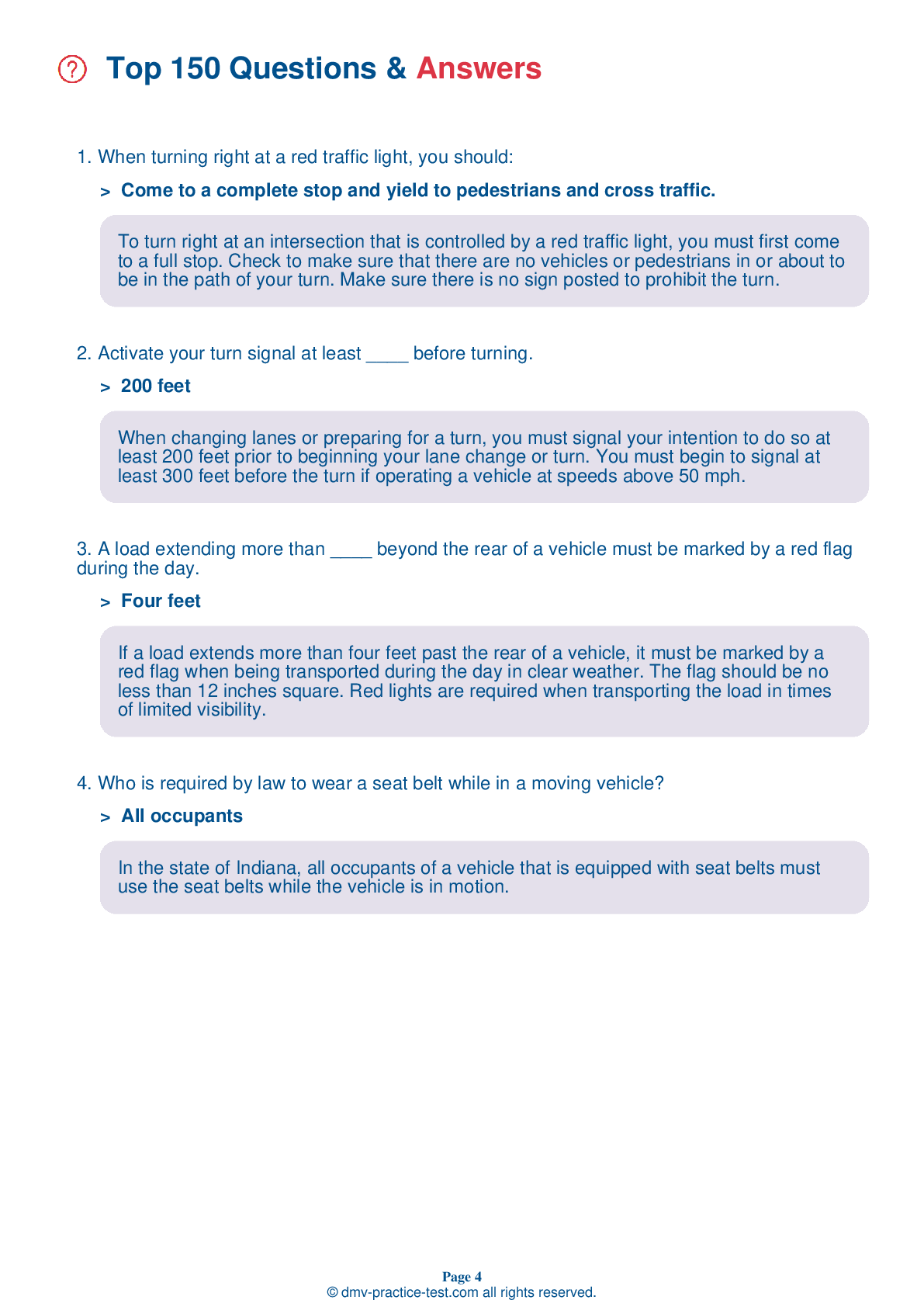FREE Indiana DMV Practice Test #8 Page 5 of 5
This set of Indiana DMV practise tests has been updated for January 2026. It includes questions based on the Indiana Driver Handbook's most significant traffic signals and laws for 2026. Use actual questions that are very similar (often identical!) to the DMV driving permit test and driver's licence exam to study for the DMV driving permit test and driver's licence exam.
On the practise exam, each question gets a tip and explanation to help you remember the concepts. The written component of the official Indiana DMV test will include questions about traffic rules, traffic signs, and driving statutes, as well as information from the Driver Handbook.
To obtain a passing grade, you must correctly answer 44 of the 50 questions. Take our DMV practise exam to help you prepare for your Indiana instruction permit or driver's licence.
The DMV exam is available in several languages.
Using any kind of testing assistance will result in an automatic fail, and the DMV may take additional action against your driver's licence, so stay away from it.
39 . This sign means:

Warning signs are usually diamond-shaped with black markings on a yellow background. They alert drivers to upcoming hazards. This sign warns drivers that the right lane is ending or that the road is narrowing ahead.
40 . A driver with a probationary license may use a telecommunications device while driving if they are:
In the state of Indiana, a person who who obtains a driver's license and is under the age of 21 is operating on a probationary driver's license. Probationary license holders may not drive while using any telecommunications devices, such as a cell phone, unless the device is being used to call 911 to report an emergency.
41 . When parallel parking between two cars, you should first:
After finding a parking space, checking traffic, and signaling, you should stop parallel to the vehicle directly ahead of your desired parking space before turning your wheel to park.
42 . Which of the following is true about driving on a wet roadway?
The faster you drive on a wet roadway, the less effective your tires will be at wiping the water from the road. If your speed becomes excessive enough, your tires will lose their grip on the road entirely and you will begin to hydroplane (that is, to slide down the road on a film of water).
43 . A yellow light that flashes on and off means:
A flashing yellow traffic light means drivers should slow down and proceed with caution.
44 . As you near an intersection, the traffic light changes from green to yellow. Your best action is to:
A steady yellow traffic light indicates that the light will soon change to red. You should be prepared to stop for the red light, if it is safe to do so.
45 . Stress can affect your driving by:
Emotions can have a great effect on your driving ability. You may not be able to drive well if you are overly worried, excited, afraid, angry, or sad. Stress can lessen your concentration on the task of driving. It is better to wait to drive than to risk driving while you are emotionally unstable.
46 . This road sign indicates:

This advisory speed sign indicates the maximum safe speed for a highway exit (in this example, 30 mph).
47 . You are driving on a narrow road when you meet an oncoming vehicle. You must:
On narrow roads, you must allow vehicles traveling in the opposite direction at least one-half of the main-traveled portion of the road. Both vehicles must have adequate space in order for the drivers to safely pass one another.
48 . What should you do when an emergency vehicle is approaching while displaying flashing red or blue lights?
You must yield the right-of-way to all emergency vehicles using a siren, air horn, and/or flashing red, blue, or white lights. Where possible, you must pull over to the right edge of the road. If you are in an intersection, drive through the intersection before you pull over.
50 . This sign means:

Warning signs prepare drivers for upcoming road conditions and hazards and are usually yellow with black markings. This sign alerts drivers that deer may cross the road in the area.
Need Car Insurance? No problem!
Compare the best rates in Indiana and find a personalized policy that meets your needs.
1. Are You Currently insured ?
2. Married ?
3. Do you own your Home?
4. Do you have more than 1 car ?
5. Have you or a Family Member Honorably Served in U.S. Military ?
6. Your Name
7. Age
8. Zip code
IMPORTANT REMINDER:Auto Insurance is Mandatory to drive in Indiana. Get covered before you hit the road to avoid any fines.
Ranked by best match




